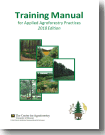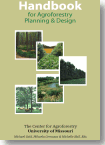Training Manual for Applied Agroforestry Practices - 2018 Edition Updated!
Plus - Handbook for Agroforestry Planning and Design

Updated in February 2019 in advance of the 7th Annual Agroforestry Academy, this updated version of the Agroforestry Training Manual is designed for natural resources professionals and landowners and includes worksheets and exercises for use as an educational tool. The manual features descriptions of establishing and managing the five agroforestry practices, plus success stories of Midwestern landowners utilizing agroforestry on agricultural and forested lands. Additional Chapters include: planning for agroforestry; wildlife habitat and agroforestry; marketing principles and economic considerations. Appendix sections include tree, shrub, grass and forage information for agroforestry plantings and timber sales suggestions. For 2019, the Additional Resources section at the end of each Chapter has been updated and expanded.
Each Chapter and Appendix Section is available for downloading:
Introduction and Table of Contents: (PDF 749 KB)
This Chapter tells how to use the Training Manual and about the Center's goals and mission. The Table of Contents is also included.
Chapter 1: Defining Agroforestry (PDF 738 KB)
Learn about the key criteria for agroforestry practices and the definition of riparian forest buffers, windbreaks, alley cropping, silvopasture and forest farming.
Chapter 2: Introduction to Planning for Agroforestry (PDF 539 KB)
The importance of developing an agroforestry work plan, and 23 detailed steps for establishing this plan, are outlined in this Chapter.
Chapter 3: Alley Cropping (PDF 1.98 MB)
Learn how alley cropping can diversify farm income, enhance wildlife and improve aesthetics, among other benefits. Tree and shrub arrangement, selection and maintenance are included, along with examples of alley cropping practices and economic incentives.
Chapter 4: Silvopasture (PDF 1.38 MB)
Silvopasture, when properly applied and well managed, can enhance farm income, provide environmental benefits and enhance wildlife habitat. This Chapter includes types of silvopasture; considerations for livestock, trees and forages; and tree spacing and arrangement, along with success stories and frequently asked questions.
Chapter 5: Upland & Riparian Forest Buffers (PDF 1.54 MB)
Riparian and upland forest buffers offer water quality benefits, streambank stabilization, wildlife habitat and alternative income opportunities, among other benefits. Learn in this Chapter how to design a riparian and upland forest buffer; how to select tree, grass and shrub species; how to maintenance a buffer; and ideas for marketing products produced from a buffer. Financial considerations and success stories are also included.
Chapter 6: Windbreaks (PDF 1.68 MB)
This Chapter will guide landowners through the process of planning, designing and managing a windbreak. Length, width and density are addressed in relation to desired windbreak function. Economic incentives and success stories are also included.
Chapter 7: Forest Farming (PDF 1.05 MB)
Forest farming improves forest health, provides additional income opportunities and diversifies farm income by incorporating trees and understory plants. This Chapter explores sustainable forest management, products derived from forest farming, and ways to utilize correct shade levels in a forest farming practice.
Chapter 8: Agroforestry and Wildlife (PDF 733 KB)
Types and amounts of wildlife that will benefit from agroforestry practices depend on the size of the agroforestry area, surrounding land uses, types of plantings, configurations of plantings, age of plantings, and the juxtaposition of different habitat types.
Chapter 9: Marketing Principles (PDF 1.12 MB)
One of the key benefits of agroforestry is the potential for a landowner to earn income form a wide range of alternative products. Understanding various dimensions of market supply, demand and research principles are important for success. This chapter gives an outline of key market considerations to decide which specialty crops to produce and how to sell them.
Chapter 10: Economic Considerations (PDF 783 KB)
This Chapter is a brief overview of the resources and information found in the Center's three Agroforestry in Action guides on economics: Economic Budgeting for Agroforestry Practices; Tax Considerations for the Establishment of Agroforestry Practices; and Funding Incentives for Agroforestry in Missouri.
Appendix Section 1: Financial Decision Support Tools. (PDF 1.47 MB)
This section has a financial guide: Economic Budgeting for Agroforestry Practices
Appendix Section 2: Trees and Shrubs for Agroforestry (PDF 821 KB)
Read suggestions for identifying the proper trees and shrubs for agroforestry practices, including a detailed table of appropriate species for Missouri.
Appendix Section 3: Grasses and Forages for Agroforestry (PDF 535 KB)
Learn what makes a forage or grass appropriate for an agroforestry practice and read suggestions on planting design and management. A table of common grass and legume forages for agroforestry practices in Missouri is featured.
Appendix Section 4: The Basics of Selling Timber (PDF 309 KB)
Landowners who do a thorough job of planning and marketing are usually satisfied with a timber harvest. Many people do not know the true value of their timber, and without planning and marketing, may receive only a fraction of their timber's true worth. Learn steps to selling timber and ways to determine your timber's value in this section. A sample timber bid form and a sample sale contract are included.
Appendix Section 5: Planning for Agroforestry Workbook (PDF 1.08 MB)
This section (p. 194-244) offers numerous workbook pages to fill in, following each step of developing and implementing an agroforestry plan that is based on the landowner's objectives and resources. (Complete this workbook after you have worked through the previous Chapters of the Training Manual.)
Appendix Section 6: Plant Resource Guide (PDF 753 KB)
A description of nearly 60 plant, tree and grass species is given, including management and harvesting considerations, propagation techniques, economic uses and additional resources for each type. Uses for agroforestry practices are also given.
Complete Training Manual (PDF 11.64 MB)
The pdf version of the updated 2018 Agroforestry Training Manual is available for downloading here.

Handbook for Agroforestry Planning and Design (PDF 1.19 MB)
Combining Training Manual Chapter 2 and Appendix 5, this new Handbook is the primary planning tool to assist in the planning and design of agroforestry practices.

